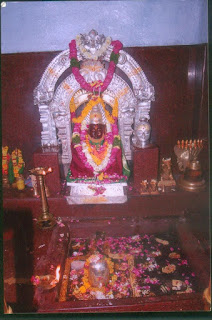Sri Ketaki Sangameswar Temple, Jharasagam
At "Jharasangam", Lord Shiva is called Ketaki Sri Sangameshwara Swamy, because here Lord Shiva is being worshipped by Ketaki flowers(generally Kethaki flowers are not used for puja), most well sainted flower. Here Lord Shiva gives darshan with Mata Parvati Devi. The Shiva Linga of Lord Shiva is installed by Lord Brahma, who came to this place, to meditate, after creation of the "Brahmanda", the Universe or the World. And the place is called "Jharasangam" because a small natural water fountain is present from which always water flows. This water is considered as very pious. Jharasangam is 15 km from Jehirabad and in Sanga Reddy district, Telengana State, in India.
 |
Sri Ketaki Sangameswar Temple, Jharasagam |
About Jharasangam Temple
Treta Yuga is the second of all the Yugas. King of Surya Vamsha called Raja Kupendra, during Treta Yuga was ailing from skin disease and had not found any remedies. One day, one of his lady servant (dasi) bring him to the Ketaki Vana where a holy pond called "Astha Thirtha Amrutha Gunda". In that holy pond Raja Kupendra took bath and Immediately, he was cured from laprosy which makes surprise to the king and king become the devotee of Lord Shiva. Then he took the darshan of the Shiva Linga, one of the oldest Shiva Linga, for a while he took rest(Vishranti) and came back to his Kingdom. Same night "Lord Shiva appeared in his dream and asked him to construct a temple on that sacred Shiva Linga". According to the Lord Shiva's guide(margdarshan), King Kupenda construct a temple over Shiva Linga and dedicated it to Lord Shiva as a mark of his gratitude. The holy pond make it as a Pushkarni. Thus the historic temple is called as "Dakshina Kasi".
 |
| Shiva Linga with Parvati Devi Installed by Lord Brahma |
Gundapooja is performed by the devotees from Karnataka, Maharashtra, Telangana and Andhra Pradesh due to its religious and historical importance of the Kshetra. At least, devotees stay one day and one night, during day time they took dip in the holy pond "Astha Thirtha Amrutha Gunda" and perform "Rudra Abhishek" to the Lord Shiva because Lord Shiva is "Abhishekpriya". And night they sleep as a "Vishranti" and took blessings(Ashirvad) of Lord Shiva and Mata Parvati Devi. Devotees perform "Kalyana of Shiva Parvati" means marriage of Lord Shiva and Parvati Devi, believing that their marriage become on time without any obstacle. At temple premises "Ashwata Vrishka" a combination of banyan and neem tree is present, a small temple of Lord Anjaneya, Lord Naganna, statue of Brahma, Vishnu and Maheshwara and a small Navagraha temple also present.
 |
| Pushkarni Ashta Tirtha Amruta Gunda |
In temple premises Choultries(Dharmashalas) are present where devotees cook food and take rest. There are two Choultries from temple authority and one is private called "Raghoji Dharmashala". One Choultry is outside the temple premises but very near to the temple. "Raghoji Dharmashala" is just infront of the temple but outside the temple premises.
Its the belief of the devotees that a dip in the holy waters of the sacred pond inside the temple is akin to taking a dip in holy Ganga river and sleeping on the temple premises is like sleeping at "Kashi Vishwanath" temple in Uttar Pradesh, a popular temple in the northern part of India which is one of the famous "Jyotirlinga" out of Twelve "Jyotirlinga".
The Pushkarni( holy pond) came to be known as "Astha Thirtha Amrutha Gunda" and pushkarni consisting of 8 thirthas are Narayana, Dharma, Rushi, Varuna, Soma, Rudra, Indira and Datha.
Here Lord Shiva is called as Kethaki Sangameshwara and the temple is one of the oldest temple.
The temple is also the home of the family deity for thousands of families in the four states, Karnataka, Telengana, Maharashtra and Andhra Pradesh. To fulfilment of their wishes devotees visiting the temple regularly and perform pooja.
सौराष्ट्रे सोमनाथं च श्रीशैले मल्लिकार्जुनम्। उज्जयिन्यां महाकालमोङ्कारममलेश्वरम्॥
परल्यां वैद्यनाथं च डाकिन्यां भीमशङ्करम्। सेतुबन्धे तु रामेशं नागेशं दारुकावने ||
वाराणस्यां तु विश्वेशं त्र्यम्बकं गौतमीतटे। हिमालये तु केदारं घुश्मेशं च शिवालये॥
एतानि ज्योतिर्लिङ्गानि सायं प्रातः पठेन्नरः। सप्तजन्मकृतं पापं स्मरणेन विनश्यति॥
एतेशां दर्शनादेव पातकं नैव तिष्ठति। कर्मक्षयो भवेत्तस्य यस्य तुष्टो महेश्वराः॥
सौराष्ट्रे सोमनाथं च श्रीशैले मल्लिकार्जुनम्। उज्जयिन्यां महाकालमोङ्कारममलेश्वरम्॥
परल्यां वैद्यनाथं च डाकिन्यां भीमशङ्करम्। सेतुबन्धे तु रामेशं नागेशं दारुकावने ||
वाराणस्यां तु विश्वेशं त्र्यम्बकं गौतमीतटे। हिमालये तु केदारं घुश्मेशं च शिवालये॥
एतानि ज्योतिर्लिङ्गानि सायं प्रातः पठेन्नरः। सप्तजन्मकृतं पापं स्मरणेन विनश्यति॥
एतेशां दर्शनादेव पातकं नैव तिष्ठति। कर्मक्षयो भवेत्तस्य यस्य तुष्टो महेश्वराः॥


0 comments:
Post a Comment
Please do not enter any spam link in the comment box